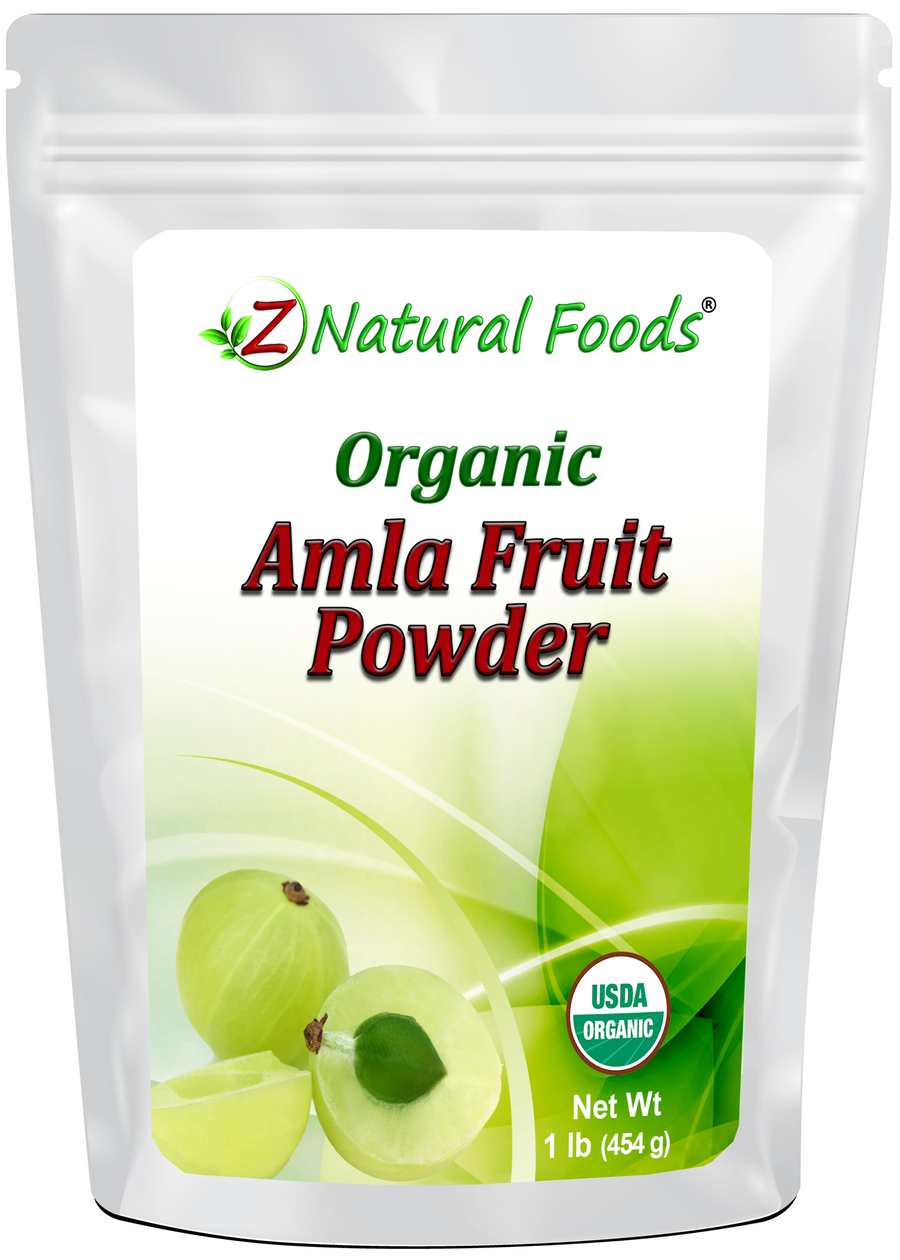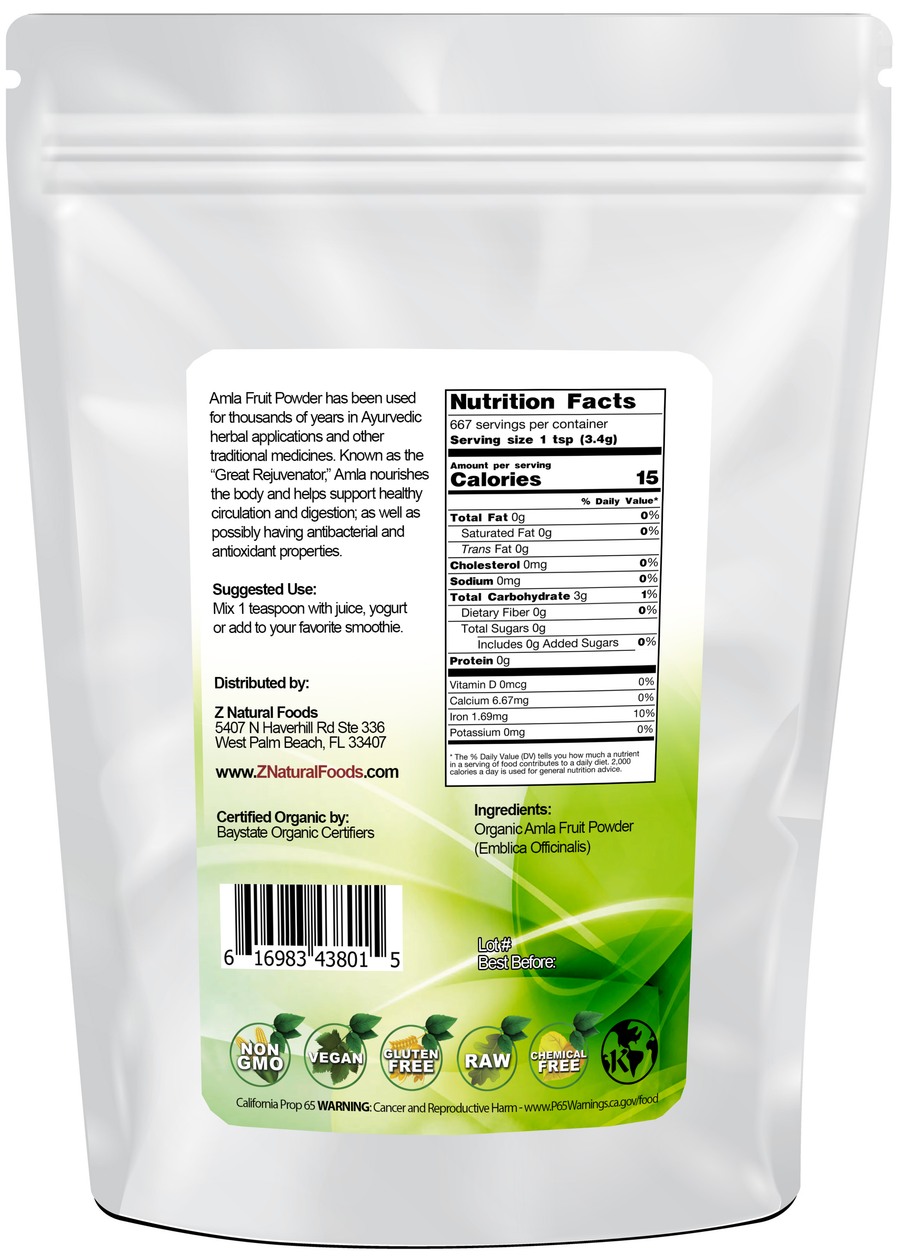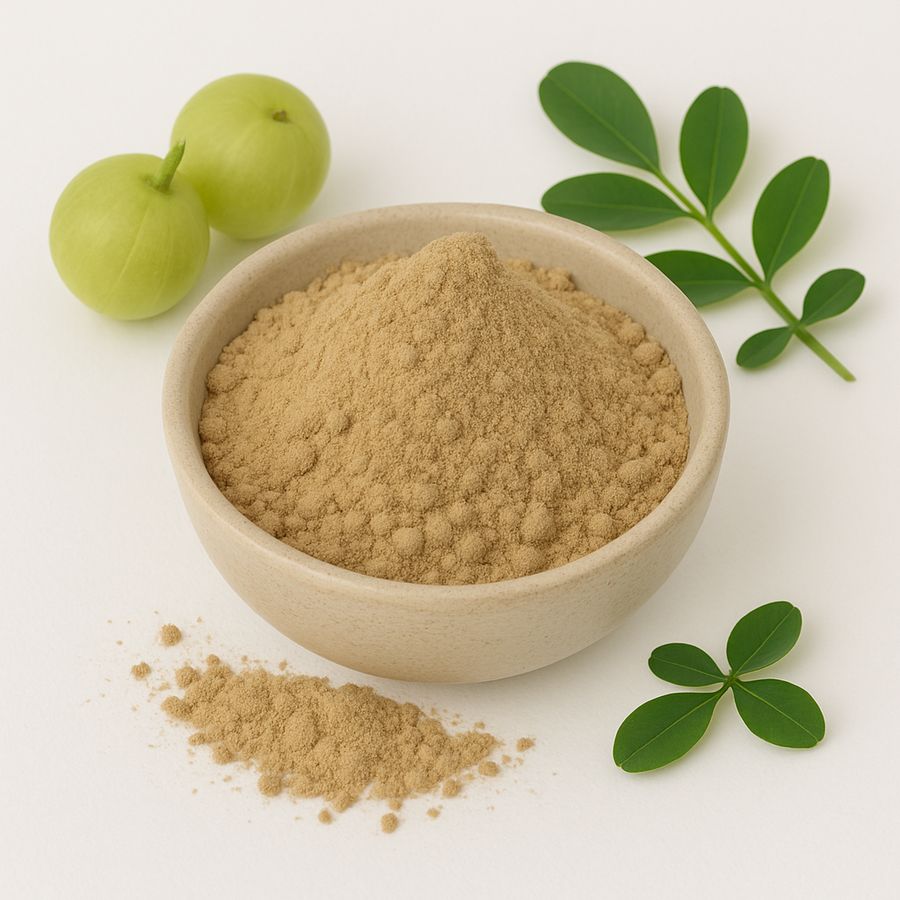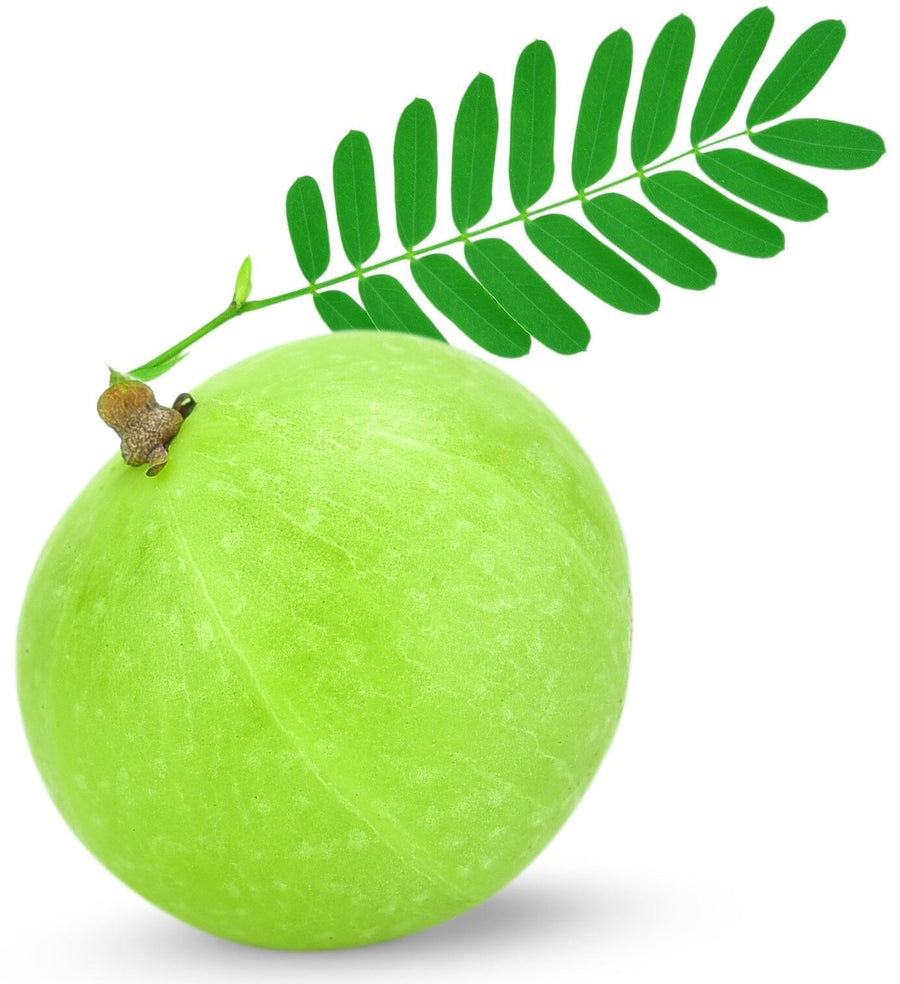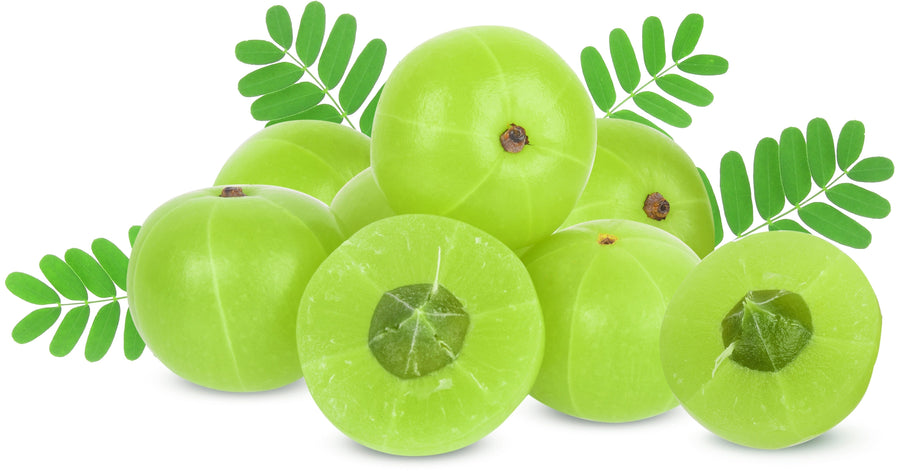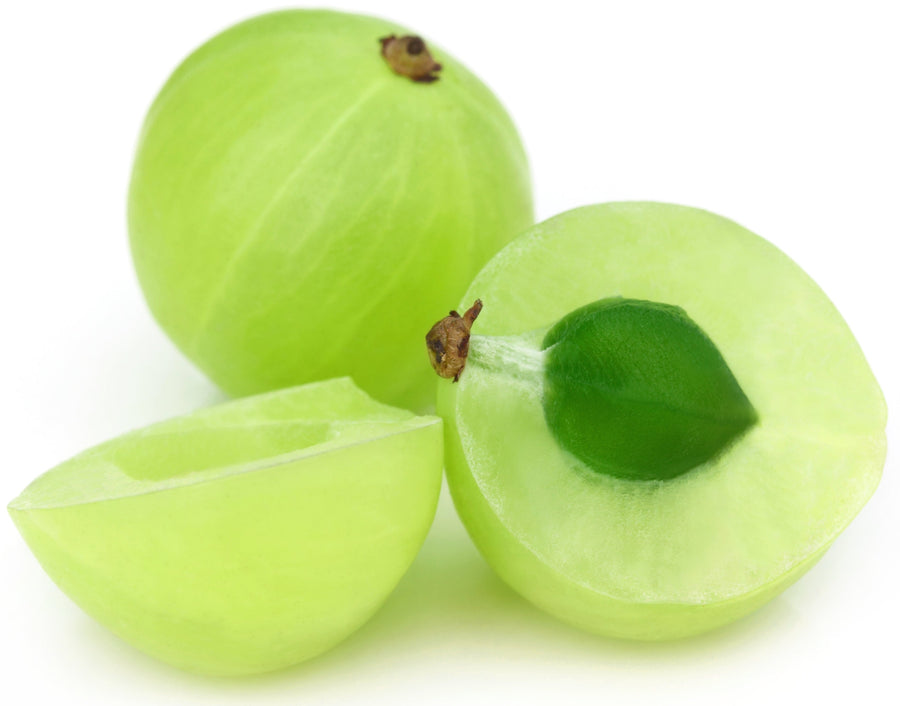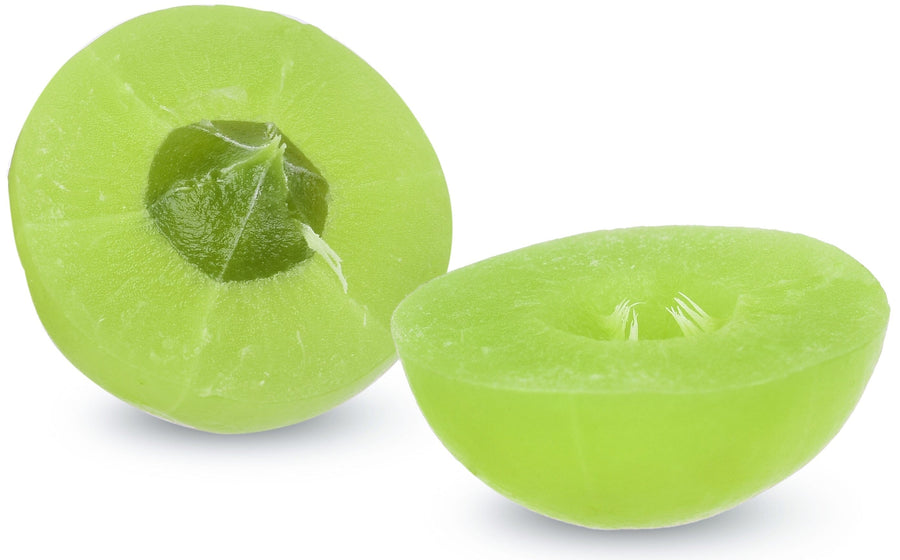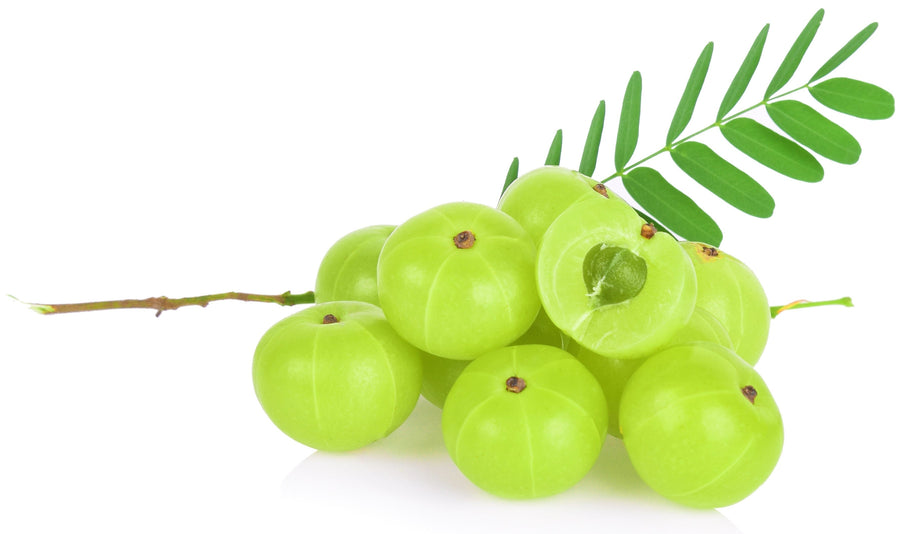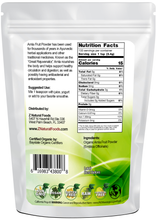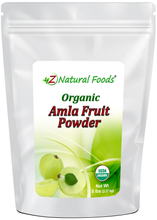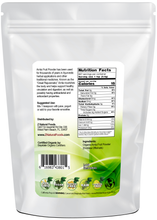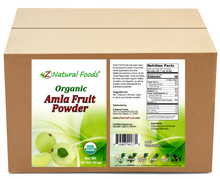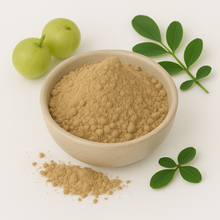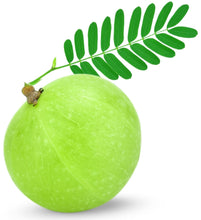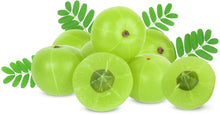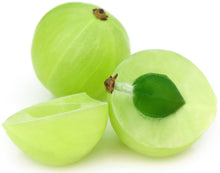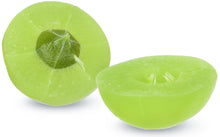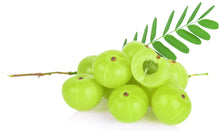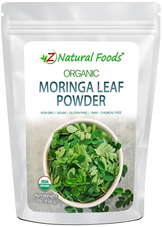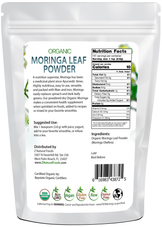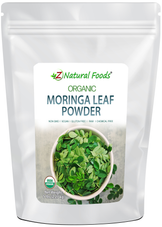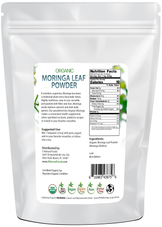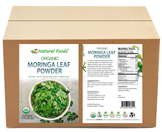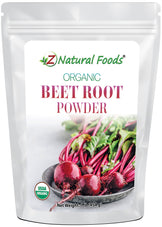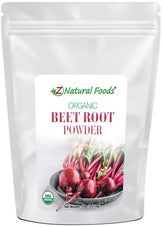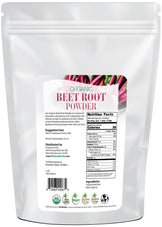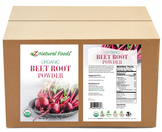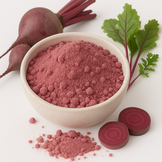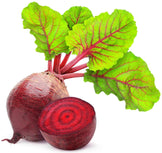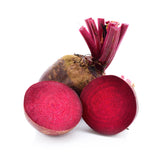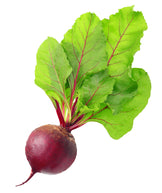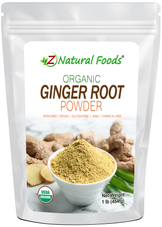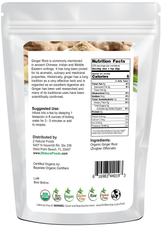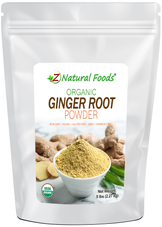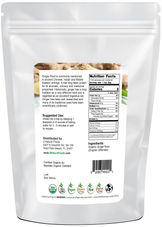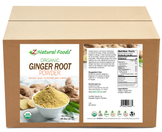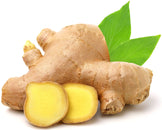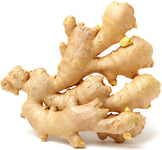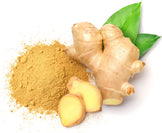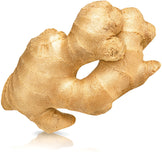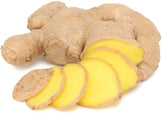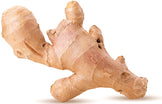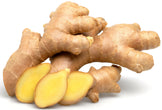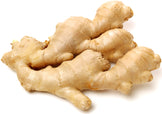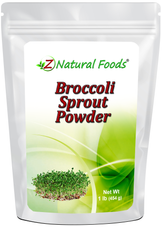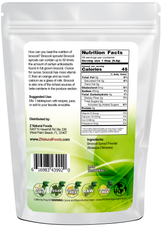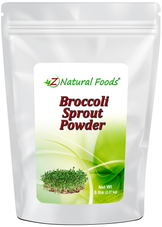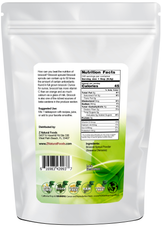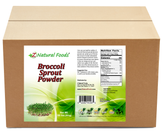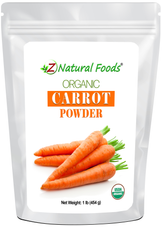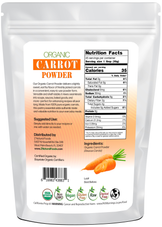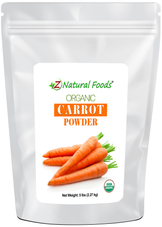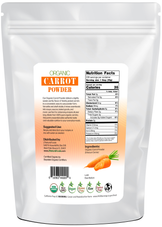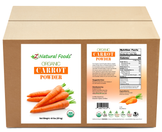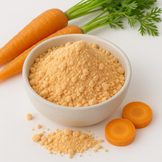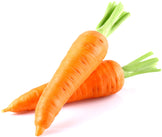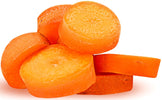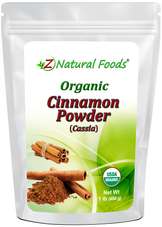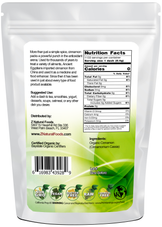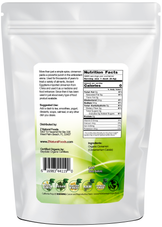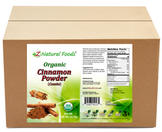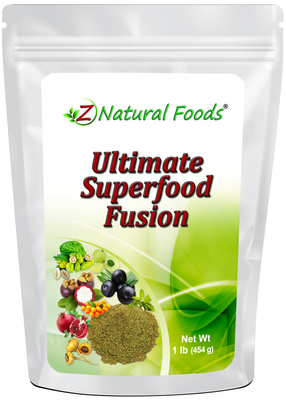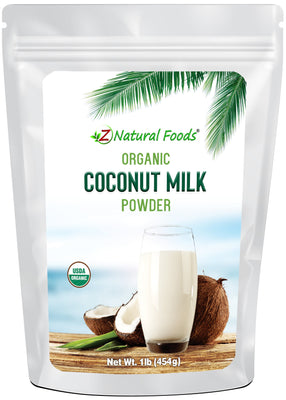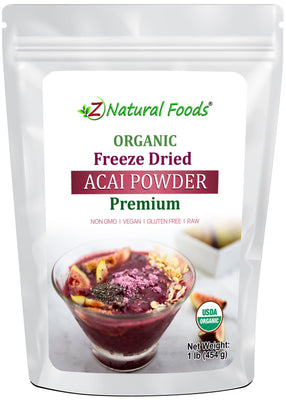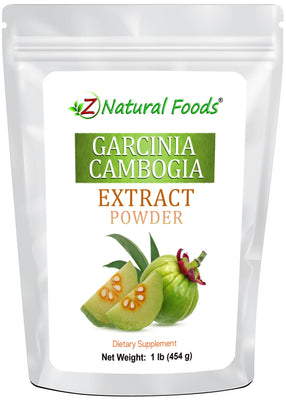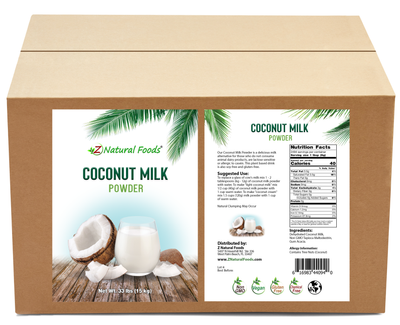About Product
Amla Fruit Powder comes from the small, yellow-green fruit native to the Indian subcontinent. Known for its tangy, sweet-and-sour flavor, amla has long been a part of traditional diets and is often used in cooking or as a snack. Today, it is widely incorporated into teas, juices, and functional food products for its distinctive taste and naturally occurring plant compounds.
Some research suggests that Amla may contain the following constituents:
Fatty Acids: linoleic, linolenic, oleic, stearic, palmitic.
Vitamins: Vitamin C
Phytochemicals: terpenoids, alkaloids, flavonoids, hydrolyzable tannins (emblicanin A, emblicanin B, pedunculagin), gallic acid, ellagic acid, 1-Ogalloyl-beta-D-glucose, 3, 6-di-O--D-glucose, acid, quercetin, corilagin, lupeol
Taste, smell, texture, and color vary from batch to batch. Due to its nature, this powder tends to clump. If clumping occurs, lay the bag on a flat surface and place a towel over the bag. Then pound on the bag until the clumps break up. The towel will help protect the bag from damage.
Suggested Use: Mix 1 teaspoon with juice and yogurt, or add to your favorite smoothie.
Mixing Suggestion: To increase the flavor and nutritional profile, combined with our organic Acerola cherry and Rosehip powders.
Miscellaneous Facts about our Organic Amla Powder
Certifications: Certified USDA Organic.
Ingredients: Raw Amla Fruit.
Parts Used: Whole Amla, no seed.
Botanical Name: Emblica Officinalis.
Other Names: Amalaki, Indian Gooseberry.
Origin: Grown and dried in India and packaged with care in Florida, USA.
* Product packaging, pictures, and origin may vary.
Sources & References
1. Ayurvedic Medicine from India. (2020). "Amla in Ayurvedic Medicine."
2. NIH. (2019). "Phytochemical and Therapeutic Potential of Amla."
3. Harvard Medical School Clinical Research Programs. (2021). "Antioxidant Properties of Amla."
4. WHO. (2020). "Amla and Immune Health."
5. Eastern Herbalism Principles. (2021). "Amla in Eastern Herbal Medicine."
6. Western Herbalism Principles. (2022). "Cardiovascular Benefits of Amla."
7. Traditional Chinese Medicine. (2021). "Amla in TCM."
8. FDA. (2021). "Cosmetic Applications of Amla."
9. Mayo Clinic Research Information Center. (2019). "Dermatological Benefits of Amla."
10. USDA. (2020). "Sustainable Cultivation of Amla."
11. Scientific Research in the former Soviet Union. (2020). "Anticarcinogenic Properties of Amla."
12. WHO. (2021). "Vitamin C Content in Amla."
13. Rege NN, Thatte UM, Dahanukar SA. Adaptogenic properties of six rasayana herbs used in Ayurvedic medicine. Phytother Res. 1999 Jun;13(4):275-91.
14. Kumar KS, Muller K. Medicinal plants from Nepal; II. Evaluation as inhibitors of lipid peroxidation in biological membranes. J Ethnopharmacol. 1999 Feb;64(2):135-9.
15. Sabu MC, Kuttan R. Anti-diabetic activity of medicinal plants and its relationship with their antioxidant property. J Ethnopharmacol. 2002 Jul;81(2):155-60.
16. Augusti KT, Arathy SL, Asha R, et al. A comparative study on the beneficial effects of garlic (Allium sativum Linn), amla (Emblica Officinalis Gaertn), and onion (Allium cepa Linn) on the hyperlipidemia induced by butter fat and beef fat in rats. Indian J Exp Biol. 2001 Aug;39(8):760-6.
17. Anila L, Vijayalakshmi NR. Flavonoids from Emblica officinalis and Mangifera indica-effectiveness for dyslipidemia. J Ethnopharmacol. 2002 Jan;79(1):81-7.
18. Kim HJ, Yokozawa T, Kim HY, et al. Influence of amla (Emblica officinalis Gaertn.) on hypercholesterolemia and lipid peroxidation in cholesterol-fed rats. J Nutr Sci Vitaminol (Tokyo). 2005 Dec;51(6):413-8.
19. Saravanan S, Srikumar R, Manikandan S, Jeya PN, Sheela DR. Hypolipidemic effect of triphala in experimentally induced hypercholesteremic rats. Yakugaku Zasshi. 2007 Feb;127(2):385-8.
20. Rao TP, Sakaguchi N, Juneja LR, Wada E, Yokozawa T. Amla (Emblica officinalis Gaertn.) extracts reduce oxidative stress in streptozotocin-induced diabetic rats. J Med Food. 2005;8(3):362-8.
21. Gao X, Zhang H, Schmidt AM, Zhang C. AGE/RAGE produces endothelial dysfunction in coronary arterioles in Type 2 diabetic mice. Am J Physiol Heart Circ Physiol. 2008 Aug;295(2):H491-8.
22. Su J, Lucchesi PA, Gonzalez-Villalobos RA, et al. Role of advanced glycation end products with oxidative stress in resistance artery dysfunction in type 2 diabetic mice. Arterioscler Thromb Vasc Biol. 2008 Aug;28(8):1432-8.
23. Stirban A, Negrean M, Gotting C, et al. Dietary advanced glycation endproducts and oxidative stress: in vivo effects on endothelial function and adipokines. Ann NY Acad Sci. 2008 Apr;1126:276-9.
24. Smit AJ, Hartog JW, Voors AA, van Veldhuisen DJ. Advanced glycation endproducts in chronic heart failure. Ann NY Acad Sci. 2008 Apr;1126:225-30.
25. Ramasamy R, Yan SF, Herold K, Clynes R, Schmidt AM. Receptor for advanced glycation end products: fundamental roles in the inflammatory response: winding the way to the pathogenesis of endothelial dysfunction and atherosclerosis. Ann NY Acad Sci. 2008 Apr;1126:7-13.
26. Bhattacharya SK, Bhattacharya A, Sairam K, Ghosal S. Effect of bioactive tannoid principles of Emblica officinalis on ischemia-reperfusion-induced oxidative stress in rat heart. Phytomedicine. 2002 Mar;9(2):171-4.
27. Antony B, Merina B, Sheeba V, Mukkadan J. Effect of standardized Amla extract on atherosclerosis and dyslipidemia. Indian J Pharm Sci. 2006;68(4):437-41.
28. Mathur R, Sharma A, Dixit VP, Varma M. Hypolipidaemic effect of fruit juice of Emblica officinalis in cholesterol-fed rabbits. J Ethnopharmacol. 1996 Feb;50(2):61-8.
29. Duan W, Yu Y, Zhang L. Antiatherogenic effects of phyllanthus emblica associated with corilagin and its analogue. Yakugaku Zasshi. 2005 Jul;125(7):587-91.
30. Yokozawa T, Kim HY, Kim HJ, Okubo T, Chu DC, Juneja LR. Amla (Emblica officinalis Gaertn.) prevents dyslipidaemia and oxidative stress in the ageing process. Br J Nutr. 2007 Jun;97(6):1187-95.
31. Cai X. Regulation of smooth muscle cells in development and vascular disease: current therapeutic strategies. Expert Rev Cardiovasc Ther. 2006 Nov;4(6):789-800.
32. Lembo G, Vecchione C, Morisco C, et al. Arterial hypertension and atherosclerosis: their epidemiology and physiopathology. Ann Ital Med Int. 1995 Oct;10 Suppl:69S-72S.
33. Jacob A, Pandey M, Kapoor S, Saroja R. Effect of the Indian gooseberry (amla) on serum cholesterol levels in men aged 35-55 years. Eur J Clin Nutr. 1988 Nov;42(11):939-44.
34. Manjunatha S, Jaryal AK, Bijlani RL, Sachdeva U, Gupta SK. Effect of Chyawanprash and vitamin C on glucose tolerance and lipoprotein profile. Indian J Physiol Pharmacol. 2001 Jan;45(1):71-9.
35. Nissen SE, Nicholls SJ, Wolski K, et al. Effects of a potent and selective PPAR-alpha agonist in patients with atherogenic dyslipidemia or hypercholesterolemia: two randomized controlled trials. JAMA. 2007 Mar 28;297(12):1362-73.
36. R&D Laboratory, Arjuna Natural Extracts Ltd PBNO 126 Alwaya Cohin Karala India. Reduction of the risk of coronary heart disease (CHD) through a multi component targeting, including CRP-levels using Amlamax' (AED-205) the standardized dry extract of Emblica officianalis Gaertn. (Indian gooseberry). 2007.
37. R&D Laboratory, Arjuna Natural Extracts Ltd PBNO 126 Alwaya Cohin Karala India. Amlama in management of dyslipidemia in humans. 2007
38. Dilaveris P, Giannopoulos G, Riga M, Synetos A, Stefanadis C. Beneficial effects of statins on endothelial dysfunction and vascular stiffness. Curr Vasc Pharmacol. 2007 Jul;5(3):227-37.
39. Kazi D, Farmer JA. Raising high-density lipoprotein cholesterol: innovative strategies against an old adversary. Curr Atheroscler Rep. 2005 Mar;7(2):88-94.
40. Paragh G, Seres I, Harangi M, et al. Ciprofibrate increases paraoxonase activity in patients with metabolic syndrome. Br J Clin Pharmacol. 2006 Jun;61(6):694-701.
41. Tomas M, Latorre G, Senti M, Marrugat J. The antioxidant function of high density lipoproteins: a new paradigm in atherosclerosis. Rev Esp Cardiol. 2004 Jun;57(6):557-69.
42. Mackness MI, Durrington PN, Mackness B. The role of paraoxonase 1 activity in cardiovascular disease: potential for therapeutic intervention. Am J Cardiovasc Drugs. 2004;4(4):211-7.
43. Costa LG, Vitalone A, Cole TB, Furlong CE. Modulation of paraoxonase (PON1) activity. Biochem Pharmacol. 2005 Feb 15;69(4):541-50.
44. Dantoine T, Debord J, Merle L, Charmes JP. From organophosphate compound toxicity to atherosclerosis: role of paraoxonase 1. Rev Med Interne. 2003 Jul;24(7):436-42.
45. van Himbergen TM, van Tits LJ, Roest M, Stalenhoef AF. The story of PON1: how an organophosphate-hydrolysing enzyme is becoming a player in cardiovascular medicine. Neth J Med. 2006 Feb;64(2):34-8.
46. Mackness B, Hine D, Liu Y, Mastorikou M, Mackness M. Paraoxonase-1 inhibits oxidized LDL-induced MCP-1 production by endothelial cells. Biochem Biophys Res Commun. 2004 Jun 4;318(3):680-3.
47. Aviram M, Kaplan M, Rosenblat M, Fuhrman B. Dietary antioxidants and paraoxonases against LDL oxidation and atherosclerosis development. Handb Exp Pharmacol. 2005;(170):263-300.
48. Graner M, James RW, Kahri J, et al. Association of paraoxonase-1 activity and concentration with angiographic severity and extent of coronary artery disease. J Am Coll Cardiol. 2006 Jun 20;47(12):2429-35.
49. Marchegiani F, Marra M, Spazzafumo L, et al. Paraoxonase activity and genotype predispose to successful aging. J Gerontol A Biol Sci Med Sci. 2006 Jun;61(6):541-6.
50. Barter PJ, Kastelein JJ. Targeting cholesteryl ester transfer protein for the prevention and management of cardiovascular disease. J Am Coll Cardiol. 2006 Feb 7;47(3):492-9.
51. Morton RE, Greene DJ. Partial suppression of CETP activity beneficially modifies the lipid transfer profile of plasma. Atherosclerosis. 2007 May;192(1):100-7.
52. Hayes JD, Kelleher MO, Eggleston IM. The cancer chemopreventive actions of phytochemicals derived from glucosinolates. Eur J Nutr. 2008 May;47 Suppl 2:73-88.
53. Mukherjee S, Gangopadhyay H, Das DK. Broccoli: a unique vegetable that protects mammalian hearts through the redox cycling of the thioredoxin superfamily. J Agric Food Chem. 2008 Jan 23;56(2):609-17.
54. Zhu H, Jia Z, Strobl JS, et al. Potent Induction of Total Cellular and Mitochondrial Antioxidants and Phase 2 Enzymes by Cruciferous Sulforaphane in Rat Aortic Smooth Muscle Cells: Cytoprotection Against Oxidative and Electrophilic Stress. Cardiovasc Toxicol. 2008 Jul 8.
55. Baek SH, Park M, Suh JH, Choi HS. Protective effects of an extract of young radish (Raphanus sativus L) cultivated with sulfur (sulfur-radish extract) and of sulforaphane on carbon tetrachloride-induced hepatotoxicity. Biosci Biotechnol Biochem. 2008 May;72(5):1176-82.
56. Tiku AB, Abraham SK, Kale RK. Protective effect of the cruciferous vegetable mustard leaf (Brassica campestris) against in vivo chromosomal damage and oxidative stress induced by gamma-radiation and genotoxic chemicals. Environ Mol Mutagen. 2008 Jun;49(5):335-42.
57. Dinkova-Kostova AT, Fahey JW, et al. Induction of the phase 2 response in mouse and human skin by sulforaphane-containing broccoli sprout extracts. Cancer Epidemiol Biomarkers Prev. 2007 Apr;16(4):847-51.
58. Wu L, Noyan Ashraf MH, Facci M, et al. Dietary approach to attenuate oxidative stress, hypertension, and inflammation in the cardiovascular system. Proc Natl Acad Sci USA. 2004 May 4;101(18):7094-9.
59. R&D Department, VDF FutureCeuticals. Blend of sprouted cruciferous seeds, SproutGarden, increases HDL blood levels. 2008.
60. R&D Department, VDF FutureCeuticals. Long-lasting inhibitory effect of blend of sprouted cruciferous seeds on Cu-induced LDL Oxidation ex vivo. 2008.
61. R&D Department, VDF FutureCeuticals. Blend of Sprouted Cruciferous Seeds, SproutGarden, reduces blood levels of oxLDL. 2008.
62. R&D Department, VDF FutureCeuticals. SproutGarden (#1) stimulates activity of Paraoxonase 1 in human blood. Acute effect case.
63. R&D Department, VDF FutureCeuticals. SproutGarden-C inhibits activity of Cholesteryl Ester Transfer Protein (CETP) in vivo. Clinical acute case study. 2008.
64. R&D Department, VDF FutureCeuticals. SproutGarden-C inhibits activity of Cholesteryl Ester Transfer Protein (CETP) in vivo. Clinical acute case study. 2008.
65. Sigal LH. Basic science for the clinician 44: atherosclerosis: an immunologically mediated (autoimmune?) disease. J Clin Rheumatol. 2007 Jun;13(3):160-8.
66. Liang CP, Han S, Senokuchi T, Tall AR. The macrophage at the crossroads of insulin resistance and atherosclerosis. Circ Res. 2007 Jun 8;100(11):1546-55.
67. Ferri C, Croce G, Cofini V, et al. C-reactive protein: interaction with the vascular endothelium and possible role in human atherosclerosis. Curr Pharm Des. 2007;13(16):1631-45.
68. Martins e Silva, Saldanha C. Diet, atherosclerosis and atherothrombotic events. Rev Port Cardiol. 2007 Mar;26(3):277-94.
69. Coppola G, Novo S. Statins and peripheral arterial disease: effects on claudication, disease progression, and prevention of cardiovascular events. Arch Med Res. 2007 Jul;38(5):479-88.
70. Jain RK, Finn AV, Kolodgie FD, Gold HK, Virmani R. Antiangiogenic therapy for normalization of atherosclerotic plaque vasculature: a potential strategy for plaque stabilization. Nat Clin Pract Cardiovasc Med. 2007 Sep;4(9):491-502.
71. Singh IM, Shishehbor MH, Ansell BJ. High-density lipoprotein as a therapeutic target: a systematic review. JAMA. 2007 Aug 15;298(7):786-98.
72. Windler E, Schoffauer M, Zyriax BC. The significance of low HDL-cholesterol levels in an ageing society at increased risk for cardiovascular disease. Diab Vasc Dis Res. 2007 Jun;4(2):136-42.
73. Jacobson TA, Miller M, Schaefer EJ. Hypertriglyceridemia and cardiovascular risk reduction. Clin Ther. 2007 May;29(5):763-77.
74. Rivera JJ, Blumenthal RS, Ashen D. Low-density lipoprotein cholesterol in high-risk asymptomatic individuals. J Cardiometab Syndr. 2007;2(1):49-52.
75. Libby P. The forgotten majority: unfinished business in cardiovascular risk reduction. J Am Coll Cardiol. 2005 Oct 4;46(7):1225-8.
76. Ali R, Alexander KP. Statins for the primary prevention of cardiovascular events in older adults: a review of the evidence. Am J Geriatr Pharmacother. 2007 Mar;5(1):52-63.
77. Kunte H, Amberger N, Ruckert RI, Harms L. Statins and their influence on inflammatory processes in internal carotid artery stenosis. Zentralbl Chir. 2007 Jun;132(3):193-7.
78. Barter PJ, Rye KA. Is there a role for fibrates in the management of dyslipidemia in the metabolic syndrome? Arterioscler Thromb Vasc Biol. 2008 Jan;28(1):39-46.
79. Doncheva NI, Nikolov KV, Vassileva DP. Lipid-modifying and pleiotropic effects of gemfibrozil, simvastatin and pravastatin in patients with dyslipidemia. Folia Med (Plovdiv). 2006;48(3-4):56-61.
80. Vaverkova H. Dual inhibition of cholesterol using the drug combination ezetimibe/simvastatin? Vnitr Lek. 2007 Apr;53(4):421-7.
81. Bhatt DL. Anti-inflammatory agents and antioxidants as a possible "third great wave" in cardiovascular secondary prevention. Am J Cardiol. 2008 May 22;101(10A):4D-13D.
82. Fedoruk LM, Wang H, Conaway MR, Kron IL, Johnston KC. Statin therapy improves outcomes after valvular heart surgery. Ann Thorac Surg. 2008 May;85(5):1521-5; discussion 1525-6.
83. Graf K, Dietrich T, Tachezy M, et al. Monitoring therapeutical intervention with ezetimibe using targeted near-infrared fluorescence imaging in experimental atherosclerosis. Mol Imaging. 2008 Mar-Apr;7(2):68-76.
84. Scheen AJ, Radermecker RP. Drug of the month. Ezetimibe/simvastatin tablet (Inegy). Rev Med Liege. 2007 Sep;62(9):585-90.
85. Stroup J, Stephens J. Combination drug products: an indication for medication reconciliation and pharmacist counseling. J Am Pharm Assoc (2003). 2008 Jul-Aug;48(4):541-3.
86. Available at: http://www.fda.gov/cder/drug/early_comm/ezetimibe_simvastatin_SEAS.htm. Accessed September 9, 2008.
87. Available at: http://www.fda.gov/Cder/drug/InfoSheets/HCP/simvastatin_amiodaroneHCP.htm. Accessed September 9, 2008.
88. Franceschi C, Bonafe M. Centenarians as a model for healthy aging. Biochem Soc Trans. 2003 Apr;31(2):457-61.
89. Manjunatha S, Jaryal AK, Bijlani RL, Sachdeva U, Gupta SK. Effect of chyawanprash and vitamin C on glucose tolerance and lipoprotein profile. Indian J Physiol Pharmacol. 2001 Jan;45(1):71-9.
90. Aneja R, Odoms K, Denenberg AG, Wong HR. Theaflavin, a black tea extract, is a novel anti-inflammatory compound. Crit Care Med. 2004 Oct;32(10):2097-103.
91. Ridker PM, Danielson E, Fonseca FA, et al. Rosuvastatin to prevent vascular events in men and women with elevated C-reactive protein. N Engl J Med. 2008 Nov 9.
92. Franceschi C. Inflammaging as a major characteristic of old people: can it be prevented or cured? Nutr Rev. 2007 Dec;65(12 Pt 2):S173-6.
93. Mach F. Inflammation is a crucial feature of atherosclerosis and a potential target to reduce cardiovascular events. Handb Exp Pharmacol. 2005;(170):697-722.
94. Fillit HM, Butler RN, O"'Connell AW, et al. Achieving and maintaining cognitive vitality with aging. Mayo Clin Proc. 2002 Jul;77(7):681-96.
95. Mishto M, Santoro A, Bellavista E, et al. Immunoproteasomes and immunosenescence. Ageing Res Rev. 2003 Oct;2(4):419-32.
96. Giunta S. Is inflammaging an auto[innate]immunity subclinical syndrome? Immun Ageing. 2006;312.
97. Franceschi C, Capri M, Monti D, et al. Inflammaging and anti-inflammaging: a systemic perspective on aging and longevity emerged from studies in humans. Mech Ageing Dev. 2007 Jan;128(1):92-105.
98. Florez H, Troen BR. Fat and inflammaging: a dual path to unfitness in elderly people? J Am Geriatr Soc. 2008 Mar;56(3):558-60.
99. Forte GI, Cala C, Scola L, et al. Role of environmental and genetic factor interaction in age-related disease development: the gastric cancer paradigm. Rejuvenation Res. 2008 Apr;11(2):509-12.
100. Katepalli MP, Adams AA, Lear TL, Horohov DW. The effect of age and telomere length on immune function in the horse. Dev Comp Immunol. 2008;32(12):1409-15.
101. Belluck P. Cholesterol-fighting drugs show wider benefit. The New York Times. November 10, 2008;A1.
102. Escobar C, Echarri R, Barrios V. Relative safety profiles of high dose statin regimens. Vasc Health Risk Manag. 2008;4(3):525-33.
103. Beltz LA, Bayer DK, Moss AL, Simet IM. Mechanisms of cancer prevention by green and black tea polyphenols. Anticancer Agents Med Chem. 2006 Sep;6(5):389-406.
104. Cameron AR, Anton S, Melville L, et al. Black tea polyphenols mimic insulin/insulin-like growth factor-1 signalling to the longevity factor FOXO1a. Aging Cell. 2008 Jan;7(1):69-77.
105. Fernandes G. Progress in nutritional immunology. Immunol Res. 2008;40(3):244-61.
106. Kussmann M, Blum S. OMICS-derived targets for inflammatory gut disorders: opportunities for the development of nutrition related biomarkers. Endocr Metab Immune Disord Drug Targets. 2007 Dec;7(4):271-87.
107. Caramia G. Omega-3: from cod-liver oil to nutrigenomics. Minerva Pediatr. 2008 Aug;60(4):443-55.
108. Crujeiras AB, Parra D, Milagro FI, et al. Differential expression of oxidative stress and inflammation related genes in peripheral blood mononuclear cells in response to a low-calorie diet: a nutrigenomics study. OMICS. 2008 Aug 7.
109. Gillies PJ. Preemptive nutrition of pro-inflammatory states: a nutrigenomic model. Nutr Rev. 2007 Dec;65(12 Pt 2):S217-20.
110. Lindi V, Schwab U, Louheranta A, et al. Impact of the Pro12Ala polymorphism of the PPAR-gamma2 gene on serum triacylglycerol response to n-3 fatty acid supplementation. Mol Genet Metab. 2003 May;79(1):52-60.
111. Tsitouras PD, Gucciardo F, Salbe AD, Heward C, Harman SM. High omega-3 fat intake improves insulin sensitivity and reduces CRP and IL6, but does not affect other endocrine axes in healthy older adults. Horm Metab Res. 2008 Mar;40(3):199-205.
112. Blazovics A, Hagymasi K, Pronai L. Cytokines, prostaglandins, nutritive and non-nuitritive factors in inflammatory bowel diseases. Orv Hetil. 2004 Dec 12;145(50):2523-9.
113. Chen HW, Lee JY, Huang JY, et al. Curcumin inhibits lung cancer cell invasion and metastasis through the tumor suppressor HLJ1. Cancer Res. 2008 Sep 15;68(18):7428-38.
114. Maron DJ, Lu GP, Cai NS, et al. Cholesterol-lowering effect of a theaflavin-enriched green tea extract: a randomized controlled trial. Arch Intern Med. 2003 Jun 23;163(12):1448-53.
115. Duffy SJ, Keaney JF, Jr., Holbrook M, et al. Short- and long-term black tea consumption reverses endothelial dysfunction in patients with coronary artery disease. Circulation. 2001 Jul 10;104(2):151-6.
116. Kebschull M, Demmer R, Behle JH, et al. Granulocyte chemotactic protein 2 (gcp-2/cxcl6) complements interleukin-8 in periodontal disease. J Periodontal Res. 2008 Oct 7.
117. Higashimoto Y, Yamagata Y, Taya S, et al. Systemic inflammation in COPD and asthma: similarities and differences. Nihon Kokyuki Gakkai Zasshi. 2008 Jun;46(6):443-7.
118. Aukrust P, Yndestad A, Smith C, Ueland T, Gullestad L, Damas JK. Chemokines in cardiovascular risk prediction. Thromb Haemost. 2007 May;97(5):748-54.
119. Steptoe A, Gibson EL, Vuononvirta R, et al. The effects of chronic tea intake on platelet activation and inflammation: a double-blind placebo controlled trial. Atherosclerosis. 2007 Aug;193(2):277-82.
120. Sugatani J, Fukazawa N, Ujihara K, et al. Tea polyphenols inhibit acetyl-CoA:1-alkyl-sn-glycero-3-phosphocholine acetyltransferase (a key enzyme in platelet-activating factor biosynthesis) and platelet-activating factor-induced platelet aggregation. Int Arch Allergy Immunol. 2004 May;134(1):17-28.
121. Cai F, Li CR, Wu JL, et al. Theaflavin ameliorates cerebral ischemia-reperfusion injury in rats through its anti-inflammatory effect and modulation of STAT-1. Mediators Inflamm. 2006;2006(5):30490.
122. Siddiqui IA, Adhami VM, Afaq F, Ahmad N, Mukhtar H. Modulation of phosphatidylinositol-3-kinase/protein kinase B- and mitogen-activated protein kinase-pathways by tea polyphenols in human prostate cancer cells. J Cell Biochem. 2004 Feb 1;91(2):232-42.
123. Siddiqui IA, Raisuddin S, Shukla Y. Protective effects of black tea extract on testosterone induced oxidative damage in prostate. Cancer Lett. 2005 Sep 28;227(2):125-32.
124. Siddiqui IA, Zaman N, Aziz MH, et al. Inhibition of CWR22Rnu1 tumor growth and PSA secretion in athymic nude mice by green and black teas. Carcinogenesis. 2006 Apr;27(4):833-9.
125. Zykova TA, Zhang Y, Zhu F, Bode AM, Dong Z. The signal transduction networks required for phosphorylation of STAT1 at Ser727 in mouse epidermal JB6 cells in the UVB response and inhibitory mechanisms of tea polyphenols. Carcinogenesis. 2005 Feb;26(2):331-42.
126. Available at: http://www.medicalnewstoday.com/articles/67591.php. Accessed October 23, 2008.
127. WG0401 protective against generalized inflammation in a human study. Unpublished data, WellGen, Inc; 2007.
128. McGuirk P, Higgins SC, Mills KH. Regulatory cells and the control of respiratory infection. Curr Allergy Asthma Rep. 2005 Jan;5(1):51-5.
129. Dreger H, Lorenz M, Kehrer A, Baumann G, Stangl K, Stangl V. Characteristics of catechin- and theaflavin-mediated cardioprotection. Exp Biol Med (Maywood). 2008 Apr;233(4):427-33.
130. Jochmann N, Lorenz M, Krosigk A, et al. The efficacy of black tea in ameliorating endothelial function is equivalent to that of green tea. Br J Nutr. 2008 Apr;99(4):863-8.
131. Scartezzini P, Speroni E. Review on some plants of Indian traditional medicine with antioxidant activity. J Ethnopharmacol. 2000 Jul;71(1-2):23-43.
132. Satiavati GV. The legacy of caraka (book review). Current Science. 2003;85:1087-90.
133. Damodaran M, Nair KR. A tannin from the Indian gooseberry (Phyllanthus emblica) with a protective action on ascorbic acid. Biochem J. 1936 Jun;30(6):1014-20.
134. Bhattacharya A, Chatterjee A, Ghosal S, Bhattacharya SK. Antioxidant activity of active tannoid principles of Emblica officinalis (amla). Indian J Exp Biol. 1999 Jul;37(7):676-80.
135. Kumar KS, Muller K. Medicinal plants from Nepal; II. Evaluation as inhibitors of lipid peroxidation in biological membranes. J Ethnopharmacol. 1999 Feb;64(2):135-9.
136. Yokozawa T, Kim HY, Kim HJ, et al. Amla (Emblica officinalis Gaertn.) attenuates age-related renal dysfunction by oxidative stress. J Agric Food Chem. 2007 Sep 19;55(19):7744-52.
137. Monnier VM, Mustata GT, Biemel KL, et al. Cross-linking of the extracellular matrix by the maillard reaction in aging and diabetes: an update on "a puzzle nearing resolution". Ann NY Acad Sci. 2005 Jun;1043:533-44.
138. Bailey AJ, Paul RG, Knott L. Mechanisms of maturation and ageing of collagen. Mech Ageing Dev. 1998 Dec 1;106(1-2):1-56.
139. Bhattacharya SK, Bhattacharya A, Sairam K, Ghosal S. Effect of bioactive tannoid principles of Emblica officinalis on ischemia-reperfusion-induced oxidative stress in rat heart. Phytomedicine. 2002 Mar;9(2):171-4.
140. Anila L, Vijayalakshmi NR. Beneficial effects of flavonoids from Sesamum indicum, Emblica officinalis and Momordica charantia. Phytother Res. 2000 Dec;14(8):592-5.
141. Kim HJ, Yokozawa T, Kim HY, et al. Influence of amla (Emblica officinalis Gaertn.) on hypercholesterolemia and lipid peroxidation in cholesterol-fed rats. J Nutr Sci Vitaminol (Tokyo). 2005 Dec;51(6):413-8.
142. Ali R, Alexander KP. Statins for the primary prevention of cardiovascular events in older adults: a review of the evidence. Am J Geriatr Pharmacother. 2007 Mar;5(1):52-63.
143. Doncheva NI, Nikolov KV, Vassileva DP. Lipid-modifying and pleiotropic effects of gemfibrozil, simvastatin and pravastatin in patients with dyslipidemia. Folia Med (Plovdiv). 2006;48(3-4):56-61.
144. Nissen SE, Nicholls SJ, Wolski K, et al. Effects of a potent and selective PPAR-alpha agonist in patients with atherogenic dyslipidemia or hypercholesterolemia: two randomized controlled trials. JAMA. 2007 Mar 28;297(12):1362-73.
145. Duan W, Yu Y, Zhang L. Antiatherogenic effects of phyllanthus emblica associated with corilagin and its analogue. Yakugaku Zasshi. 2005 Jul;125(7):587-91.
146. Cai X. Regulation of smooth muscle cells in development and vascular disease: current therapeutic strategies. Expert Rev Cardiovasc Ther. 2006 Nov;4(6):789-800.
147. Lembo G, Vecchione C, Morisco C, et al. Arterial hypertension and atherosclerosis: their epidemiology and physiopathology. Ann Ital Med Int. 1995 Oct;10 (Suppl):69S-72S.
148. Jacob A, Pandey M, Kapoor S, Saroja R. Effect of the Indian gooseberry (amla) on serum cholesterol levels in men aged 35-55 years. Eur J Clin Nutr. 1988 Nov;42(11):939-44.
149. Antony B, Benny M, Kaimal TNB. A pilot clinical study to evaluate the effect of Emblica officinalis extract (Amlamax®) on markers of systemic inflammation and dyslipidemia. Indian J Clin Biochem. 2008; 23(4):378-81.
150. R&D Laboratory, Arjuna Natural Extracts Ltd PBNO 126 Alwaya Cohin Karala India. Unpublished study on Amlamax®.
151. Cucuianu M, Coca M, Hancu N. Reverse cholesterol transport and atherosclerosis. A mini review. Rom J Intern Med. 2007;45(1):17-27.
152. Rainwater DL, Rutherford S, Dyer TD, et al. Determinants of variation in human serum paraoxonase activity. Heredity. 2008 Oct 29.
153. Rajak S, Banerjee SK, Sood S, et al. Emblica officinalis causes myocardial adaptation and protects against oxidative stress in ischemic-reperfusion injury in rats. Phytother Res. 2004 Jan;18(1):54-60.
154. Yoshida H, Ishikawa T, Hosoai H, et al. Inhibitory effect of tea flavonoids on the ability of cells to oxidize low density lipoprotein. Biochem Pharmacol. 1999 Dec 1;58(11):1695-703.
155. Holvoet P. Relations between metabolic syndrome, oxidative stress and inflammation and cardiovascular disease. Verh K Acad Geneeskd Belg. 2008;70(3):193-219.
156. Lindberg G, Rastam L, Nilsson-Ehle P, et al. Serum sialic acid and sialoglycoproteins in asymptomatic carotid artery atherosclerosis. ARIC Investigators. Atherosclerosis Risk in Communities. Atherosclerosis. 1999 Sep;146(1):65-9.
157. Moussa MA, Alsaeid M, Refai TM, et al. Association of serum sialic acid with cardiovascular metabolic risk factors in Kuwaiti children and adolescents with type 1 diabetes. Metabolism. 2004 May;53(5):638-43
158. Coylewright M, Blumenthal RS, Post W. Placing COURAGE in context: a review of the recent literature on managing stable coronary artery disease. Mayo Clin Proc. 2008 Jul;83(7):799-805.
159. Kapetanakis EI, Medlam DA, Boyce SW, et al. Clopidogrel administration prior to coronary artery bypass grafting surgery: the cardiologist's panacea or the surgeon's headache? Eur Heart J. 2005 Mar;26(6):576-83.
160. Shafiq N, Malhotra S, Pandhi P, Grover A. The "Statinth" wonder of the world: a panacea for all illnesses or a bubble about to burst. J Negat Results Biomed. 2005 Mar 23;4:3.
161. Czyz M, Watala C. Aspirin" the prodigious panacea? Molecular mechanisms of the action of acetylsalicylic acid in the organism. Postepy Hig Med Dosw (Online). 2005 Mar 23;59:105-15.
162. Lim MC. Drug-eluting stents: the panacea for restenosis? Singapore Med J. 2004 Jul;45(7):300-2.
163. Molavi B, Rasouli N, Mehta JL. Peroxisome proliferator-activated receptor ligands as antiatherogenic agents: panacea or another Pandora's box? J Cardiovasc Pharmacol Ther. 2002 Jan;7(1):1-8.
164. Angiolillo DJ, Guzman LA, Bass TA. Current antiplatelet therapies: benefits and limitations. Am Heart J. 2008 Aug;156(2 Suppl):S3-S9.
165. Derosa G, Salvadeo S, Cicero AF. Recommendations for the treatment of hypertension in patients with DM: critical evaluation based on clinical trials. Curr Clin.Pharmacol. 2006 Jan;1(1):21-33.
166. El Desoky ES, Derendorf H, Klotz U. Variability in response to cardiovascular drugs. Curr Clin Pharmacol. 2006 Jan;1(1):35-46.
167. Scartezzini P, Speroni E. Review on some plants of Indian traditional medicine with antioxidant activity. J Ethnopharmacol. 2000 Jul;71(1-2):23-43.
168. Satiavati GV. The Legacy of Caraka (Book Review). Current Science. 2003;85:1087-90.
169. Muruganandam AV, Kumar V, Bhattacharya SK. Effect of poly herbal formulation, EuMil, on chronic stress-induced homeostatic perturbations in rats. Indian J Exp Biol. 2002 Oct;40(10):1151-60.
* Reviews & Success Stories Disclaimer
Product reviews solely reflect the views and opinions expressed by the contributors and not those of Z Natural Foods. Z Natural Foods does not verify or endorse any claims made in these reviews. Statements have not been evaluated by the FDA and are not intended to diagnose, treat, cure, or prevent any disease or health condition.REFERRAL PROGRAM
Share your personal link to your friends and welcome them with rewards. Claim yours when they make their first purchase.

GIVE
$10 off discount

GET
$10 off discount
Other products in the same category
Ultimate Superfood Fusion
$51.57
Coconut Milk Powder
$374.40
